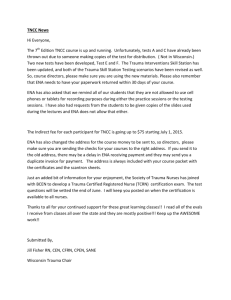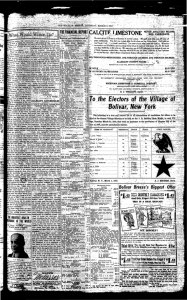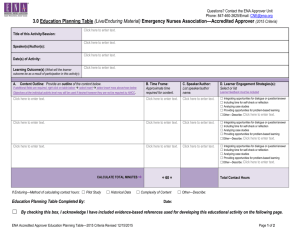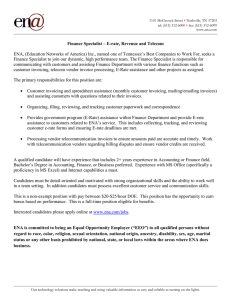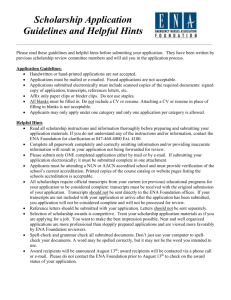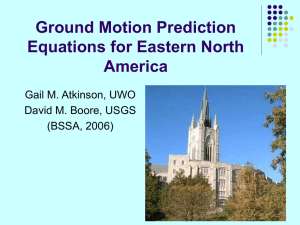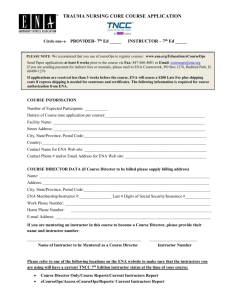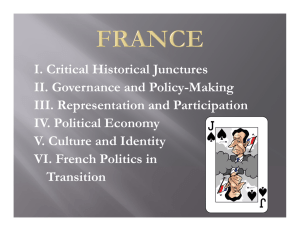HANA PA’A Community Forestry and Environmental Research Partnerships Pre-Dissertation Fellowship
advertisement
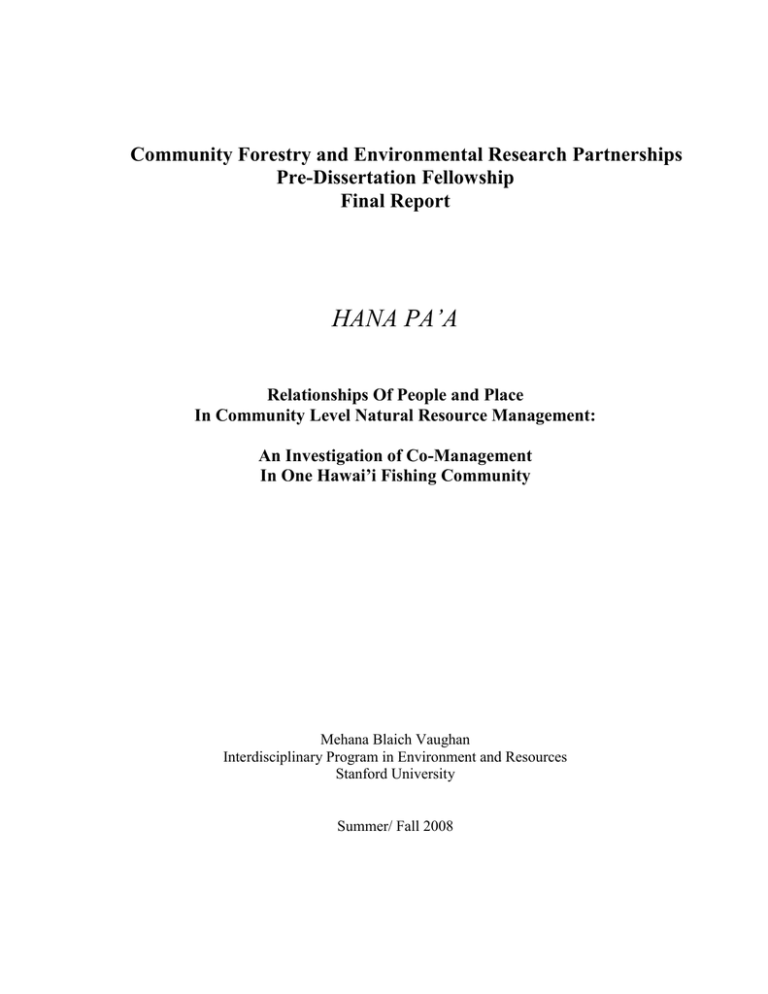
Community Forestry and Environmental Research Partnerships Pre-Dissertation Fellowship Final Report HANA PA’A Relationships Of People and Place In Community Level Natural Resource Management: An Investigation of Co-Management In One Hawai’i Fishing Community Mehana Blaich Vaughan Interdisciplinary Program in Environment and Resources Stanford University Summer/ Fall 2008 DISSERTATION ABSTRACT This research focuses on place-based communities with a long history of relationships between people and the natural resources of their area. I study how local level systems of resource management have developed over time, and how they continue to change, as communities form co-management partnerships with government agencies and other organizations to respond to forces impacting natural resource health from further and further away. I want to understand how the partners share rights and responsibilities, adapt to changes, resolve conflicts, and learn from one another. I also seek to understand how to train future generations to again manage resources at the local level within the context of co-management partnerships. These questions are explored through an embedded single case study approach using participatory mixed methods including interviews, surveys, and mapping. This research is conducted in collaboration with one rural, fishing community in Hawai’i. It focuses on local residents’ efforts to manage in-shore marine resources in partnership with state government agencies and a conservation NGO. This research is important because similar collaborative, comanagement partnerships are gaining credibility as a promising alternative to solely government or market-based tools for addressing a range of pressing environmental problems. This research uses a uniquely broad lens to consider one such partnership for local level resource management, not at a static moment in time, but in light of historical context, present patterns of use, and leadership development into the future. By situating co-management within broader relationships between people and place, this research stands to contribute to our understanding of how such partnerships work, and their potential as a tool for enhancing social-ecological sustainability. If we’re not fishing, we don’t know what we’re taking care of. --Ha’ena Fisherman, President of Hui Maka’ainana o Makana You need to be able to paint a picture and tell a story people can understand, of what this place is like now, what it would be like in five years if you don’t do anything, and what it will be like if your community succeeds. --Chairperson, Hawai’i State Department of Land and Natural Resources speaking to members of the Ha’ena community (August 2008) Pre-Dissertation Fellowship Final Report I) ACCOMPLISHMENTS TO DATE The primary goal of my pre-dissertation fellowship work was to identify a community partner for my dissertation research, on community based resource management at the ahupua’a level in Hawai’i, and to develop research questions together. At the start of the fellowship, I knew I would be conducting research in the area where I grew up, the rural Northern coast of the island of Kaua’i. I had identified five different community organizations on the island as potential research partners. Over the course of the fellowship, I was able to attend meetings, interview policy makers and leaders of a number of these organizations, and establish a research partnership in the community of Ha’ena. I interviewed six different individuals working in Ha’ena, attended community meetings, and walked the coast with community members as part of their coastal monitoring project. I am partnering with the Ha’ena community group Hui Maka’ainana o Makana (HMOM), and with the Community Conservation Network (CCN). Hui Maka’ainana o Makana is a non-profit dedicated to perpetuating Hawaiian culture as a way of life through the practice of and participation in ahupua’a based management in Ha’ena.1 The Community Conservation Network works with community groups asserting local level fisheries management throughout Hawai’i, including Ha’ena. Representatives of both groups worked with me to develop and refine research questions. These questions build on work the community has already accomplished and aim to answer some of their current research needs. Based on these questions, I wrote and defended my dissertation proposal in Spetember ‘08. The fellowship made it possible to accomplish the work necessary to advance to candidacy. Now I am able to be on Kaua’i full time to begin data collection with HMOM and CCN. BACKGROUND: Ha’ena, which means “the intense breath of the sun” in Hawaiian, is located on the Northwest side of the island of Kaua’i. The state highway ends at Ha’ena and the Na Pali district begins, steep cliffs interspersed with weathered valleys accessible only by boat and a narrow trail.2 Encompassing approximately 1800 acres, Ha’ena stretches from the back ridges of two valleys, Manoa (vast) and Limahuli (turning hands), to a large coastal plain and fringing reef. The area is well known for its rich fishing grounds . The name Hui Maka’ainana o Makana means “Organization of Maka’ainana of the cliff Makana.” Maka’ainana, frequently translated as “commoner” literally means “ eyes or sprouts of the land” (Puku’i 1978, Andrade 2008). 2 Many of the Hawaiian families of Ha’ena have ancestral ties to the district of Na Pali. Accounts from the 1960s and 70s record Ha’ena residents continuing to live seasonally in Kalalau and other valleys, sending fish, goats and other food home to families in Ha’ena by horseback (Andrade 2008). 1 Archaeological evidence points to inhabitation of this area well before 1000 AD, primarily centered on fishing, with taro cultivation and other forms of farming more prevalent by 1700 AD. Today, few Hawaiian families continue to own land within the ahupua’a. The 1910 Federal Census found 67 residents of Ha’ena (65 were Hawaiian, 2 were Asian) living in 15 households. The most recent census, in 2000, found 602 residents (32% part Hawaiian) residing in 233 houses (Ha’ena State Park Master Plan 2001, 2000 Census). More than half of these are not permanent residences, but vacation rentals, many with lot prices upwards of one million dollars (Stokes 2005). Descendants of the Hawaiian families of the area still maintain ties to the lands and resources of Ha’ena, continuing subsistence farming and fishing practices. In 1985, a number of these descendants formed Hui Maka’ainana o Makana. Activities initiated by the Hui Maka’ainana over the last twenty years include working with State Parks to develop a Master Plan for the 40-acre Ha’ena state park (visited by over 900,000 people per year, primarily tourists), restoration of lo’i kalo (taro terraces) within the park, caring for cultural sites in the area, and monitoring health of the area’s coral reef. Besides fishing, other marine activities in the area include recreational uses such as kayaking, surfing, kite surfing, and snorkeling, and commercial uses such as scuba diving lessons. Natural resource management in Hawai’i is highly centralized under the jurisdiction of the State Department of Land and Natural Resources (DLNR). DLNR has twelve different divisions overseeing everything from forests, to hunting and wildlife, to fresh water, to state parks, to cultural and historic resources, to the coastline. For awhile, people in Ha’ena have been concerned by declining fish populations. They felt centralized state management under the Division of Aquatic Resources (DAR), one branch of DLNR, was ineffective at controlling threats to marine resources. Examples included over-fishing and large numbers of snorkeling tourists walking on the reef. In addition, DAR regulations establishing closed seasons for certain fish, didn’t always match spawning times for the same species in Ha’ena. In 2006, members of HMOM worked with Kaua’i’s legislative representatives to draft a bill establishing a community based subsistence fishing area (CBSFA) at Ha’ena. The bill called for “the inhabitants of the ahupua’a develop and assist in development and enforcement of traditional regulations” for the entire coastline fronting the ahupua’a of Ha’ena, from the shoreline to a distance of one mile out to sea or the outer edge of the coral reef (S.B. 2501, 23rd Leg., Reg. Sess. (HI 2006). The law, Act 241, passed in 2006, allows the community to make and enforce their own marine rules for in partnership with the Department of Aquatic Resources. Ha’ena is one of only two Hawai’i communities with this status. It is a model for at least six other communities currently pursuing similar co-management agreements with the DLNR. With assistance from the Community Conservation Network, the community and DAR are currently beginning this rule making process. This research focuses on this process, along with other current community efforts at local level resource management. RESEARCH QUESTIONS: If we’re not fishing, we don’t know what we’re taking care of. --Ha’ena Fisherman, President of Hui Maka’ainana o Makana You need to be able to paint a picture and tell a story people can understand, of what this place is like now, what it would be like in five years if you don’t do anything, and what it will be like if your community succeeds. --Chairperson, Hawai’i State Department of Land and Natural Resources speaking to members of the Ha’ena community (August 2008) 1) What is the present state of relationships3 between people and resources in this area under the existing state-level management system? (Who is using the resource and how?) Sub ?s: How do recreational/commercial uses overlap with subsistence fishing areas and ecologically significant areas? What are patterns of use (year/time of day)? How well do patterns of use map onto the community based subsistence fishery management partnership? (i.e. which users are involved in the process or not) Members of the community are already engaged in data collection to establish base line ecological health of the coral reef and fishery, as well as base line data on resource use (number of individuals engaged in recreational, subsistence fishing and other activities, and amount of fish caught). I will assist with these data collection efforts, particularly in surveying users, then organizing meetings to bring together all user groups to discuss new regulations proposed by the HMOM. We have also discussed my assisting by setting up GIS access in Ha’ena and training with community members so that we can map resource and use data. Ha’ena fishermen emphasize sharing the fish they catch to feed family and friends. Some of them are interested in mapping distribution of fish from the fishery and the number of households being fed. This connects to a broader question of how to assess, not only the ecological impacts of community based fisheries management, but the socio-economic and cultutal impacts as well. While the duration of this research is too short to assess these effects, we will work on establishing baseline indicators. By “relationships,” I mean, (1) the rights, responsibilities, and relationships between people using the resource as well as with the resource itself, and (2) people’s knowledge, beliefs, and practices related to the resources. Please note that the three research questions outlined here are each really broad and I’m aware that my dissertation may not be able to address all sub-questions thoroughly for each. Questions will be further refined in discussion with partners as the research proceeds. 3 2) What is the state of relationships between people and resources in the process of developing a co-management partnership in this area? Sub ?s: What are different partners’ goals and how do they judge success? How are resources, benefits, and responsibilities of the partnership allocated? What are some key challenges faced by the partnership and how might these be overcome? CCN and Hui Maka’ainana o Makana are both interested in assessing the progress of their partnership with the State DLNR. CCN in particular sees the Ha’ena partnership as a model for other communities. While I will conduct some of the data collection on this question myself (interviewing DLNR staff), members of both CCN and HMOM will participate in focus group discussions, interviews, and data analysis. I may also work with CCN to survey three – five other subsistence fishing communities in Hawai’i about their experiences partnering with DLNR. We would use themes emerging from Ha’ena to design the survey in order to understand how findings from this case study may or may not apply to other Hawai’i communities. 3) What are the partners in this co-management partnership (particularly youth participants from the community) learning, and how? Older members of Hui Maka’ainana o Makana raised this question of what youth in this partnership are experiencing. They are concerned about the long term sustainability of their efforts and how to build the capacity of the younger generation to replace them in leadership positions. Ha’ena is unique among CCN’s partner communities in its high level of youth participation. Youth participate in a summer program run by the Hui, in Ma Kai Watch, a program through which community members monitor resource use in the area, and as newly elected board members for the Hui. Our goal is to engage a number of these youth in answering this question through data collection and analysis. They will map what they know about the fishery, and video tape one another in fishing and resource management activities at different points in the process. In focus groups, they will discuss these maps and videos, and what they reveal about their learning, along with their own feelings about participation. II) PRELIMINARY FINDINGS 1) Founders of Hui Maka’ainana o Makana, responsible for the group’s many achievements up to this point, have recently turned over leadership within the group to younger members of the community, aged 22-25. However, one obstacle for young people is economic. Often, paid positions in community based resource management require degrees. Some young people involved in this project are frustrated because they are volunteering, spending their own money for equipment and supplies, while individuals not from the community are getting paid. They have proposed ideas for fund raising, such as setting up an informational kiosk and selling crafts to tourists alongside the areas they’re caretaking and restoring. However, these ideas have been discouraged because commercial activity is not allowed in the park. 2) Young participants feel they are learning and gaining skills in areas such as communication. A number expressed increased confidence in approaching and talking with fishermen, tourists, and others about appropriate behaviors. They seem to feel their work is important, that they are exercising their responsibility to care for Ha’ena. 3) Some participants described monitoring and use as synonymous. They monitor by fishing, observing resources as they go. However, the partnership with DAR requires more formal monitoring. While the monitoring program is welcome because it employs three young people, it also causes conflicts. For example, while these monitors can describe broad patterns of use (tourists leave the beach in the mid-day heat, kite boarders come out when it’s windy and travel across the reef), they have recorded very little observation data. We wonder whether state agencies will accept their reporting of changes in marine resources and use patterns. In the summer, monitors observed fingerlings of a particular species, schooling in areas and quantities unseen in Ha’ena for over a decade. This informal observation provides encouragement that their efforts to manage the fishery are working. 4) Communication is a challenge. Partners such as staff at DAR tend to contact certain members of the community and word doesn’t always get to everyone involved in the project. In addition, different divisions within the DLNR such as state parks and DAR do not always communicate with one another about their work with the same community. Many in the community do not have email, some do not have home phones, and cell phone reception is spotty in Ha’ena. Getting people to meetings is a challenge and decisions occurring in meetings do not always align with what’s being done day to day on the ground. III) SUCCESSES AND CHALLENGES Participating with CFERP was extremely helpful in this process of partnering and collaboratively planning research. While I knew I wanted to undertake participatory research, the resources offered by CFERP helped me to understand ways in which aspects of my original proposal were not participatory at all. They increased my understanding of participatory research theory and methods, provided a framework through which to consider my research, and guided me to engage community partners from the beginning. Also, having a more solid foundation in participatory research, and a network of fellows undertaking similar research helped me to justify a participatory approach to my committee, most of whom don’t use PR/PAR in their own research. One challenge I continue to face is how to engage a diversity of members of the Ha’ena community. Before launching into the data collection phase of my dissertation, I would like to spend more time in the community, with Hui Maka’ainana o Makana, as well as with community members who do not belong to the organization. Another challenge is navigating my role as researcher. A few individuals have asked me to facilitate the process of creating community based rules for management of the fishery. I am talking with community members to better understand reasons for this request. We are also discussing whether and how my taking that role could build community capacity. There is sentiment among some in Ha’ena that they are doing all the work, while others (researchers, government officials etc.) take the credit. I am aware that the process of gaining trust is ongoing and will be determined not by what I say, but what we do together over the next two years. IV) IMPACTS Preliminary impacts of Ha’ena’s community based subsistence fisheries management project are outlined below. I would like, however, to emphasize that these impacts are not a result of my involvement. So far, my work has primarily focused on planning a project which we have not yet implemented. Expected impacts of my research are listed separately. Existing impacts of the project: o Three young people are now employed monitoring and educating users about fishery. o Educational exchanges and connections with other Hawai’i communities engaged in similar efforts. o Partnership in which all twelve divisions of the State Department of Land and Natural Resources collaborate on interfacing with Ha’ena community. Ha’ena is one of only four communities in Hawai’i with this status. o Initial biological survey conducted in September. Expected impacts: o Increased youth capacity to lead, monitor, communicate with resource users and partners, and educate other youth. o Improved partnerships through better understanding of challenges to partnership (i.e. state divisions do not cooperate which means the community has to go to multiple sets of repetitive meetings etc.), and ways in which the partnership may undermine as well as strengthen community efforts. o Increased understanding of patterns of resource use in fishery. o Increased ability to communicate these patterns through more systematic record keeping of monitoring data. o Methods for monitoring both socio/cultural and ecological impacts of community management of fishery. V) LESSONS In researching one collaborative resource management partnership between government agencies and community groups, I am learning how much depends on individuals. Individual personalities and relationships seem to affect the process more than official laws, administrative policies, or program goals. I have also learned that participatory research requires a greater investment of time at the beginning. Building relationships in a partner community cannot be rushed, nor can agreements on research questions, approaches, and processes for working together. Investing this time at the beginning should provide a more solid foundation for the rest of the research. I am excited to work with Hui Maka’aina o Makana and the Community Conservation Network to begin data collection on our research questions in Ha’ena. Mahalo a nui loa (thank you deeply) to CFERP for funding the foundations of this research. Mahalo especially for believing in, supporting, and educating about participatory research approaches in the field of community based resource management. Mahalo to the following individuals who helped to shape this research: Atta Forrest Chipper Wichman Hau’oli Wichman Kawika Winters Megan Juran Maka’ala Ka’aumoana Jeff Chandler Ka’imi Hermosura Ka’ili Chandler Debbie Gowensmith RESOURCES: Andrade, Carlos. (2008). Ha’ena: Through the Eyes of the Ancestors. Honolulu: University of Hawai’i Press. Berkes, Fikret, and Carl Folke, eds. 1998. Linking Social and Ecological Systems: Management Practices and Social Mechanisms for Building Resilience. Cambridge University Press, Cambridge Berkes, Fikret and Carl Folke, eds. 2002. Linking Social and Ecological Systems. Cambridge University Press, Cambridge. Friedlander, Alan, Poepoe, Helm, Abbott, et al. (2000 October). “Application of Hawaiian Traditions to Community-Based Fishery Management.” International Coral Reef Symposium. Bali, Indonesia. Kauaian Institute. Ka`imi Stokes (2007). Kaua`i Indicators Project. Kilauea, HI. Kauaian Institute. (2003). Kaua’i Town Demographics: A Statistical and Geographic Analysis Based on the 2000 Census. Kapa’a, HI: Kauaian Institute. Pinkerton, E., ed. (1989). Cooperative Management of Local Fisheries: New Directions for Improved Management and Community Development. Vancouver: UBC Press. Poepoe, Kelson K., Bartram, Paul K., and Alan M. Friedlander. (2006). The Use of Traditional Knowledge in the Contemporary Management of a Hawaiian Community’s Marine Resources. Fisher’s Knowledge in Fisheries Science and Management. ISBN 978-92-3-105029-0, 117-141. UNESCO 2006. Puku`i, Mary Kawena and Samuel Elbert. (1971). Hawaiian Dictionary. Honolulu: University Press of Hawai`i. Wichman, Frederick B. (1998). Kaua`i: Ancient Place-Names and Their Stories. Honolulu: University of Hawai`i Press, Honolulu, Hawai`i.
